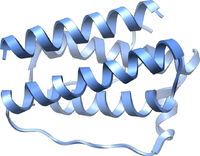
Photo from wikipedia
AIMS Hypertension is a prevalent yet poorly understood feature of polycystic kidney disease. Previously we demonstrated that increased glutamatergic neurotransmission within the hypothalamic paraventricular nucleus produces hypertension in the Lewis… Click to show full abstract
AIMS Hypertension is a prevalent yet poorly understood feature of polycystic kidney disease. Previously we demonstrated that increased glutamatergic neurotransmission within the hypothalamic paraventricular nucleus produces hypertension in the Lewis Polycystic Kidney rat model of polycystic kidney disease. Here we tested the hypothesis that augmented glutamatergic drive to the paraventricular nucleus in Lewis Polycystic Kidney rats originates from the forebrain lamina terminalis, a sensory structure that relays blood-borne information throughout the brain. METHODS AND RESULTS Anatomical experiments revealed that 38% of paraventricular nucleus-projecting neurons in the subfornical organ of the lamina terminalis expressed Fos/Fra, an activation marker, in Lewis Polycystic Kidney rats while <1% of neurons were Fos/Fra+ in Lewis control rats (P = 0.01, n = 8). In anaesthetised rats, subfornical organ neuronal inhibition using isoguvacine produced a greater reduction in systolic blood pressure in the Lewis Polycystic Kidney versus Lewis rats (-21 ± 4 vs. -7 ± 2 mmHg, P < 0.01; n = 10), which could be prevented by prior blockade of paraventricular nucleus ionotropic glutamate receptors using kynurenic acid. Blockade of ionotropic glutamate receptors in the paraventricular nucleus produced an exaggerated depressor response in Lewis Polycystic Kidney relative to Lewis rats (-23 ± 4 vs. -2 ± 3 mmHg, P < 0.001; n = 13), which was corrected by prior inhibition of the subfornical organ with muscimol but unaffected by chronic systemic angiotensin II type I receptor antagonism or lowering of plasma hyperosmolality through high-water intake (P > 0.05); treatments that both nevertheless lowered blood pressure in Lewis Polycystic Kidney rats (P < 0.0001). CONCLUSION Our data reveal multiple independent mechanisms contribute to hypertension in polycystic kidney disease, and identify high plasma osmolality, angiotensin II type I receptor activation and, importantly, a hyperactive subfornical organ to paraventricular nucleus glutamatergic pathway as potential therapeutic targets. TRANSLATIONAL PERSPECTIVE Hypertension is a significant comorbidity for all forms of chronic kidney disease and for individuals with polycystic kidney disease, often an early presenting feature. Nevertheless, the cause(s) of hypertension in polycystic kidney disease are poorly defined. Here we define the contribution of a neural pathway that contributes to hypertension in polycystic kidney disease. Critically, targeting this pathway may provide an additional antihypertensive effect beyond that achieved with current conventional antihypertensive therapies. Future work identifying the drivers of this neural pathway will aid in the development of newer generation antihypertensive medication.
Journal Title: Cardiovascular research
Year Published: 2021
Link to full text (if available)
Share on Social Media: Sign Up to like & get
recommendations!